Tags
Ancient Ensemble of Tonkin, Cultural Mosaic, Dam Quang MInh, Hanoi, Hanoi New Music Ensemble, Hanoi Old Quarter, Hong Kong New Music Ensemble, In the Path of the Ancestors, Jan Karlin, Nguyen Thien Dao, Tet Offensive 1968, Vietnam National Academy of Music, Vu Nhat Tan

The world premiere of Kim Thủy Hỏa by Vũ Nhật Tân.
”Bác Jeff!” breathlessly whispered one of my Vietnamese colleagues, hurriedly finding me back stage as we were all getting ready to perform. “We must wait to start the concert. We have over 1,000 people trying to find seats, more than the auditorium can handle. Uncle Jeff this never ever happen before!”
In the Path of the Ancestors indeed proved to be the right title at the right time for the Hà Nội New Music Ensemble. Post concert noise and chatter continues to flood the city’s cultural discussions while both Vietnamese national and international television networks can’t seem to get enough of me, resulting in very good media exposure for a new music group in its fourth season.

Cameras rolling for my interview with VTV1 and the nightly news broadcast.
Here’s the recipe list for our Vietnamese success. Three now continuous generations of Vietnamese composers, young (Lương Huệ Trinh) middle (Vũ Nhật Tân) and old (Nguyễn Thiện Đạo). Two brilliant guest artists from our neighbors in the superb Hong Kong New Music Ensemble (Karina Yau and Chronicle Li). Devoted Vietnamese musicians (lead by Phạm Trường Sơn, Bảo Cóc and Vũ Nhật Tân) in a long term relationship with a two-time Grammy Award winning conductor and his visionary violist/advisor/coach/author wife from Los Angeles, an important center internationally for new music (yours truly and my wife Jan). Collaboration with revered Vietnamese national treasures in the Ancient Ensemble of Tonkin/Đông Kinh Cổ Nhạc (led by Đàm Quang Minh). Media exposure from national television networks VTV1 (domestic nightly news) and VTV4 (a Cultural Mosaic feature interview for domestic and international audiences). Multiple press and digital outlet reports. A Facebook-monsoon both before and after the concert. Elated emails of congratulations from Paris by Nguyễn Thiện Đạo’s widow Hélène. The visible advocacy of an esteemed Vietnamese poet laureate, Nguyễn Duy, in the audience. The support of the Grand Hall of the Việt Nam National Academy of Music with its world class acoustics (thank you, Japan).
And, last but not least, the best concert banners in the world!

Concert banner at the Việt Nam National Academy of Music.
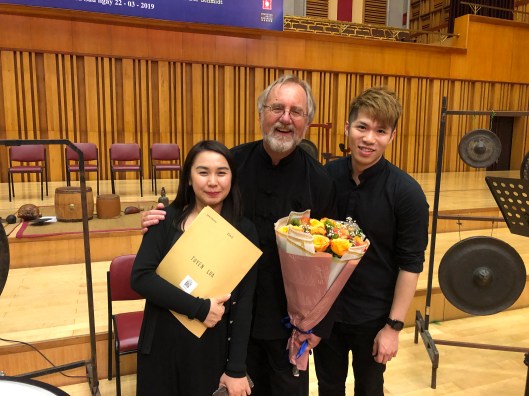
With Hong Kong friends percussionists Karina Yau and Chronicle Li.
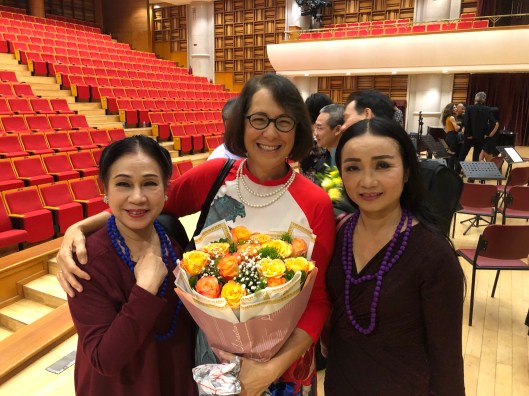
Jan with national treasures Thanh Hoài and Minh Gái.
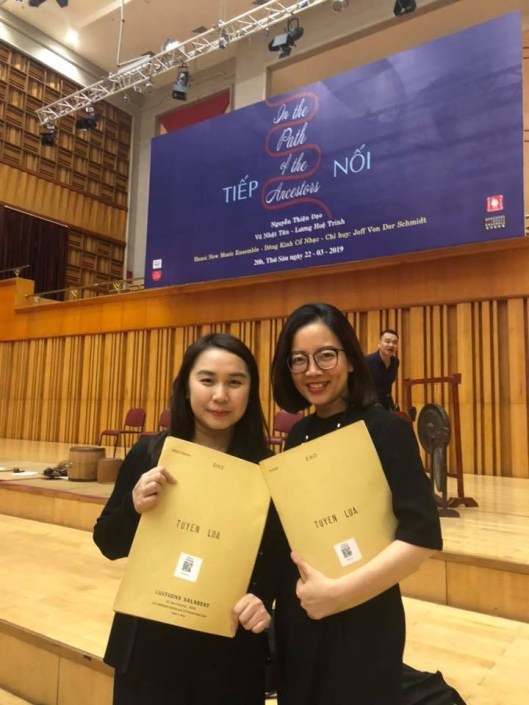
Percussionist Karina Yau of Hong Kong and pianist Tâm Ngọc Trần of Hà Nội.

At Loading T Coffee for a post concert interview with Minh Hiền of VTV4.
There were three works on the program, ending with a magnum opus world premiere from Vũ Nhật Tân, a Vietnamese premiere of Nguyễn Thiện Đạo in the middle, and a repeat performance of Jiji by Lương Huệ Trinh to open, which received its Vietnamese premiere the preceding week at a portrait concert for Trinh welcoming her back from her studies in Hamburg. That concert was a co-production of the Goethe Institut and the Institut Français and proved a powerful debut. I’ve written another post about Trinh, and should you be interested you’ll easily find it here a few posts back on Sound Travels.
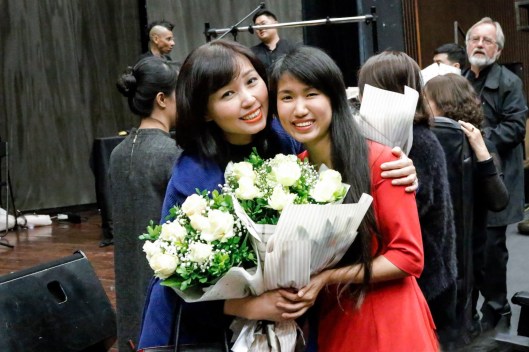
Đàn tranh soloist Phạm Trà My congratulates Lương Huệ Trinh at L’espace.
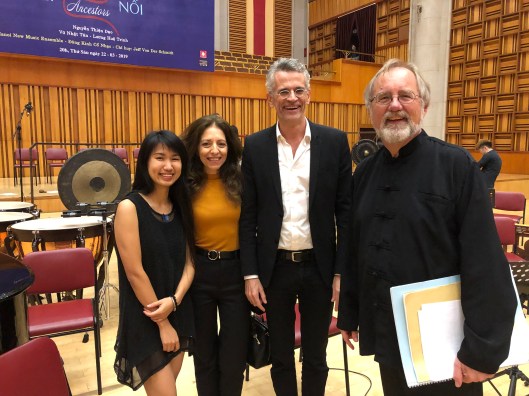
Trinh, Mona and Emmanuel Labrande of the Institut Français and me after the VNAM concert.
The finale of In the Path of the Ancestors was the world premiere of Kim Thủy Hỏa, the second installment of The Five Elements by Vũ Nhật Tân. By 2020-21 we anticipate the final part to appear, or as Tân calls it “the final circle,” creating a full concert inspired by the poetry of Nguyễn Duy, who has written a powerful work about climate change with a Vietnamese perspective. This project is a major collaboration of cultural institutions, bringing together the Ancient Ensemble of Tonkin/Đông Kinh Cổ Nhạc and the Hà Nội New Music Ensemble. Our mutual intention, from gestation to completion, is to refocus attention on Việt Nam as a country, not a war.
With 1,000 dragons rising to hear the results thus far, we’re on the best path!
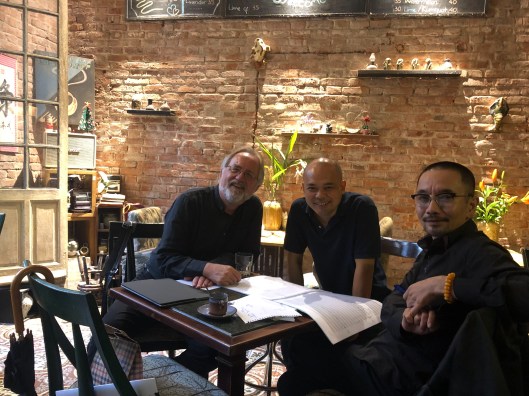
Planning session in the Old Quarter with me, Tân and Minh.

Minh surveying the rehearsal landscape of both groups.
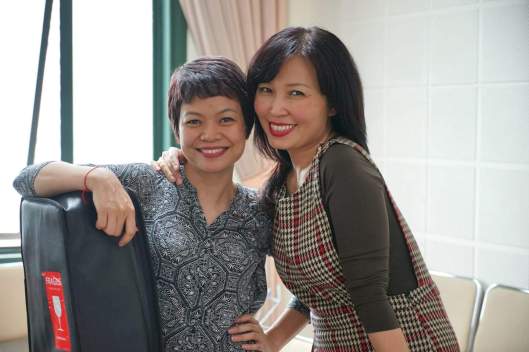
Đàn bầu and đàn tranh soloists Ngô Trà My and Phạm Trà My.

Trần Thư Thủy, vocal soloist with the Hà Nội New Music Ensemble.

Setting up for the dress rehearsal.
Refocusing national and international attention on Việt Nam as a country and not a war is, however, not a singular perspective of our collaborative work. Because Việt Nam remains a war for many French and Americans, the cauldron of 20th century revolutionary conflict that ended extractive European colonialism and a confused interventionism of the United States. Best to stay away from Việt Nam if you’re a minimalist thinker reducing complex history to a single answer.
Because the triumph of the success of In the Path of the Ancestors concert was the overwhelming response by the packed to the rafters Vietnamese public for the ferocious music of Nguyễn Thiện Đạo. Cheers, tears and bravos. This was a homecoming for my friend who tragically passed away in 2015 right as I was beginning this journey. Tuyến Lửa, or Frontlines, was written in exile in Paris in 1968 and is Đạo’s response to the carnage of the Tết Offensive, and the Vietnam War in general.
Make that wars, plural.
Wars with France. Japan and World War II. France returns. The United States. Cambodia. China. And then from ancient history, China. Go further back, China again. A 1,000 year occupation by their forever determined northern neighbor, one who will never go away, defines the Vietnamese national character, both in positive and negative ways. These are deep cultural oceans and rivers. After ten trips here I’ve finally got my head above water. Đạo put all of this into a masterpiece for his country. Fight me if you think otherwise.
On March 22, 2019, Nguyễn Thiện Đạo came home to an adoring public played willingly by Vietnamese musicians. They’d requested me to program a piece of his and I did my best to choose the right one to spark a national revival.
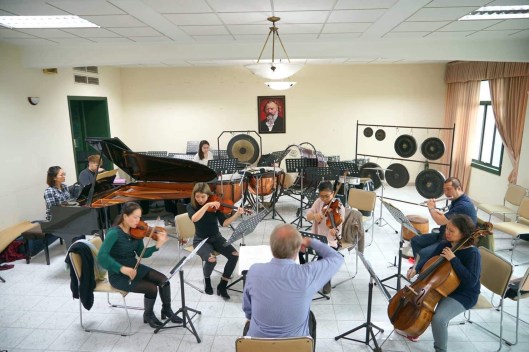
Rehearsing Đạo’s Tuyến Lửa.
I am always learning a lot here in Việt Nam, it’s one of the attractions of returning to the place. This trip one new essential I’d missed was knowing about The Four Immortals. I’d been working on Đạo’s score for a long time, there are easily a million notes to keep a conductor busy. Most of the movements are titled in French: Fusées, Anti-lumiére, Alpha Stol, Printemps au Automne I and Printemps au Automne II. But the final movement switches to Vietnamese, Phù-Đổng-Thiên-Vương. I tried my dictionaries and Google translate but resigned myself while studying in California to a title that had a meaning based on the combination of words, which my teacher here has given me as a helpful guide when I’m stumped. And stumped I was.
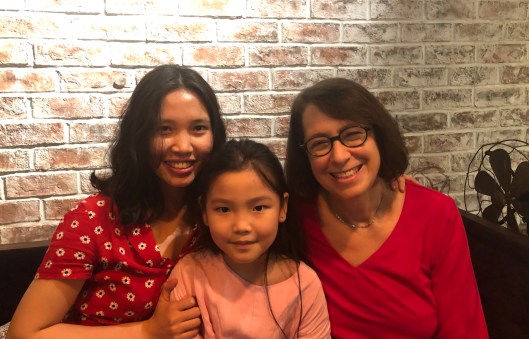
Our teacher Nguyễn Thanh Hoa and her daughter Bảo Trần with Jan.
To be brief, Phù Đờng is a mythological child hero who grows exponentially into a man in just a few days, rapidly eating bowls and bowls of rice. Once grown, his name changes to Thiên Vương. This Boy Hero rides into battle to liberate Việt Nam on an Iron Horse armed with an Iron Javelin to defeat, you guessed it, the Han Chinese. So much for Đạo referencing only conflict with France or the United States in his 1968 masterpiece. Silly me didn’t know about Phù-Đổng-Thiên-Vương.
Here he’s a popular video game known to everyone!

Tâm Ngọc Trần of Hà Nội and Karina Yau of Hong Kong discussing details.
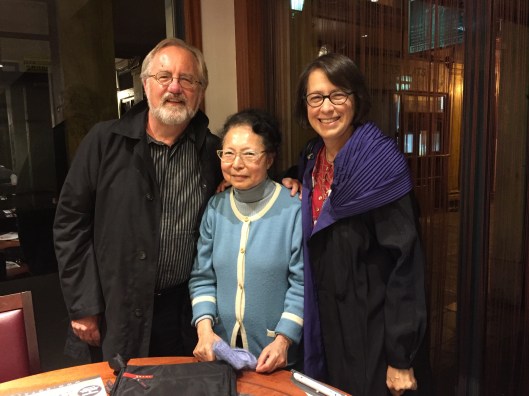
Hélène Đạo sent inspiring best wishes to Hà Nội. We were all together in 2017 in Paris.
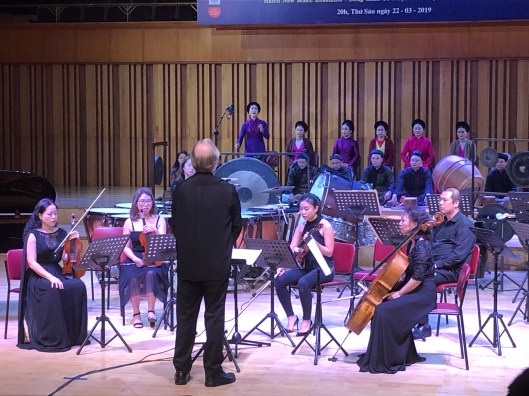
One of the great moments in music.
But I’ve saved the best for last. In the midst of two types of music – all hell breaking loose or deep and somber reflection about the cost of war – Đạo asked for an ancient Vietnamese song between movements. We decided to go all out and not use the 1968 digital transfer of an old Vietnamese song of Đạo’s choosing. The old members of the Ancient Ensemble of Tonkin knew Đạo, and lead the way insisting that they quietly sit behind the ensemble. Someone in the audience took the photo above, capturing the moment when finally a lone Vietnamese woman stood up to sing, followed by her colleagues. They became the Voices of the Ancestors.
One of the most stirring musical moments I have ever experienced.
Đạo studied with Olivier Messiaen so you’d be correct to assume that there are number sequences all over this piece. And my players were quite aware of their significance. The Number 9 is the most revered in Việt Nam, driving the piece to its overwhelming conclusion. I could easily write a book about the numerology of Tuyến Lửa. But I don’t need to for a Vietnamese audience, or any other audience for that matter. The ending of the Tuyến Lửa is a triumphant moment of victory lead by Phù-Đổng-Thiên-Vương.
You’d be a rock not to feel it.
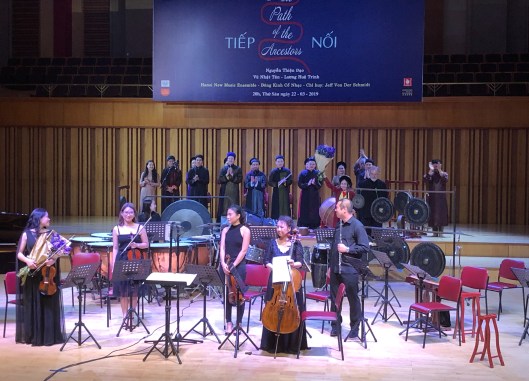
Thanh Hoài (in red in the back) holding flowers high after Tuyến Lửa.

Triumphant bows for an appreciative audience.
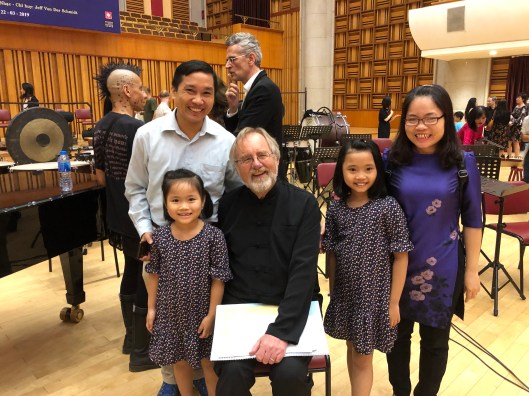
On stage autographs are normal with families.

Happy smiles backstage.

With poet laureate Nguyễn Duy.
”Thank you Mr. Jeff, your performance of Mr. Đạo’s music purified my heart from the war years.” Sharing this experience together with Mr. Duy in the audience will live on and on in my heart. If you’re a music critic don’t read the next sentence. Mr. Duy’s remark was perhaps the best review of my life.
And with that, it was time to party in the Old Quarter!

Getting drunk together in the Old Quarter.
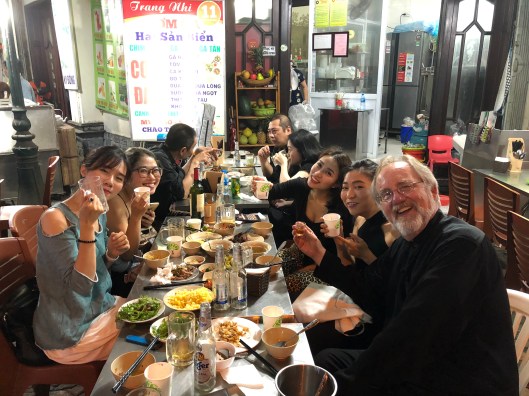
Cheering on my young players.
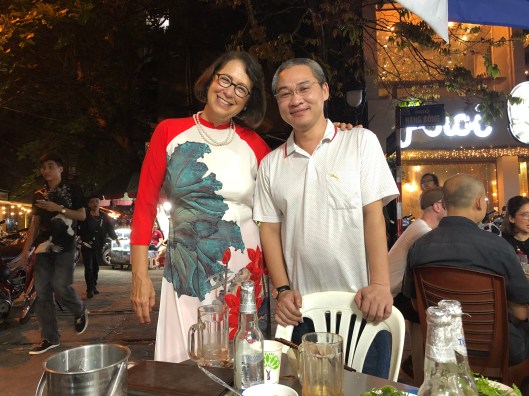
Jan with our old friend Bảo Cóc.
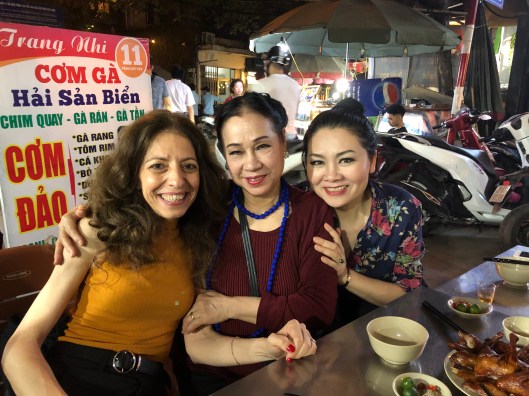
A new era for France and Việt Nam, too!
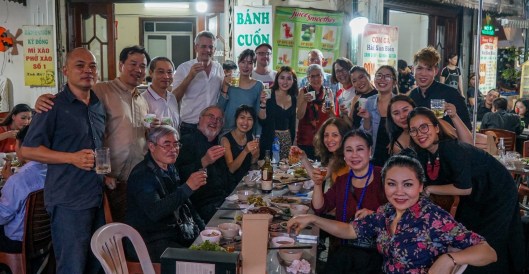
The group that drinks together plays together!
If you know how to look at the photo above you can see how music changes the world. This is an unthinkable photo in the 20th century. A toast between friends from France, the United States, China and Việt Nam after a concert of uncompromising new music that was a hit with the public. That’s a potent antibiotic for the global and very dangerous Crazy-town politics of this era, with a crisis du jour in every exhausting headline.

New group photo for the Hà Nội New Music Ensemble.
There are certainly more exciting chapters to be written about my work here with the Hà Nội New Music Ensemble. Jan and I are planning together right now for the future with our Vietnamese colleagues. But we are satisfied that In the Path of the Ancestors established institutional momentum, something that is elusive to quantify.
We’d officially call this moment an inflection point. In simple turns, it was one hell of an accomplishment and we’re proud of everybody working together!
Best, best, best,
Jeff

Reblogged this on HANOI NEW MUSIC ENSEMBLE .
Pingback: Tie^’p va` No^’i ON the PATH of the ANCESTORS | vunhattangroup